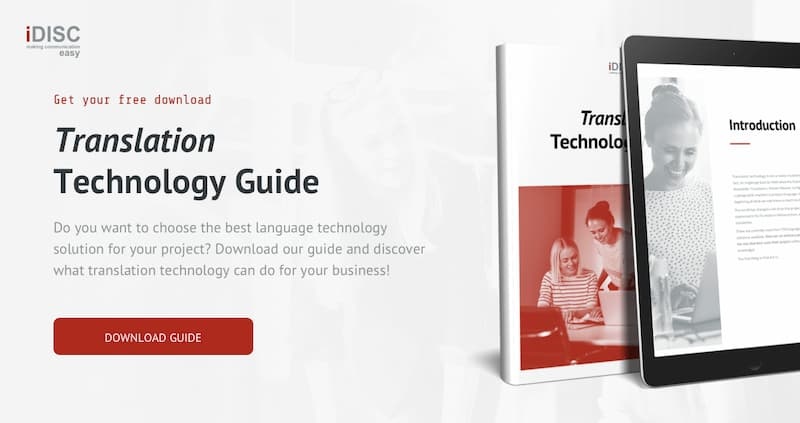Translation is an essential service for most businesses, which are forced to adapt to changes in technology in order to remain competitive: internet, software, communication tools, the phenomenon of globalization and internationalization, etc.
Since its beginning, technology has been closely linked to the translation process, as it has been for many other activities essential for the development of our society and which, over the years, have been increasingly perfected.
By translation technology we mean all software tools that optimize and streamline the process of converting written text from one language to another.
Currently, we can find over 700 technological solutions on the market designed to assist with the translation process. However, not all are suitable for the same tasks.
When content needs to be translated or adapted into another language, the choice of one tool or another will depend on the nature of the text and the purpose of the translation.
Therefore, in this article we will tell you about the main translation technology tools and the functionalities of each one of them, so that you can decide which one best suits your needs and those of your project.
aim!
CAT Tools
CAT Tools (Computer Aided Translation) or CAT Tools are translation tools that use translation software to translate documents from one language into another software created to assist the translator in the task of adapting texts from one language to another and make this process faster and more efficient. Its main objective is to simplify repetitive reference tasks so that the translator can concentrate all his or her attention on more key aspects of the text itself.
These tools make it possible to integrate in the same environment all the information and elements that linguists need to carry out their work, such as glossaries or reference materials, streamlining the process and facilitating the search and research task for translators.
Features of CAT tools
CAT tools make the translator’s job much easier.
Some of their most beneficial features are:
Segmented text
Facilitates the translator's reading and comprehension of the original text by segmenting it into translation units i.e. the source language sentences appear aligned with the target language sentences. In this way, visualization facilitates the review process.
Translation memories
These tools use translation memories or Translation Memories (TMs). it is a bilingual corpus that saves previous translations for reuse in subsequent assignments. In this way, a kind of warehouse or database is created for each language pair, which makes it possible to find segments that have already been translated and can be reused in the new job. This can improve consistency in the text and speed up the work.
Autocomplete
CATs, together with translation memories, offer the possibility of auto-completion. In this case, the software automatically proposes segments that are already included in the translation memory. The proposed segments will depend on the match they present to the new original text, which can be exact (exact match) or partial (fuzzy match).The larger the translation memory is, the more likely it will suggest asuitablesegmentfor our text.
Glossaries
Specialized terminology glossaries are also used. These glossaries can be updated as needed for the project at hand. For certain disciplines or very specific subjects, the role of glossaries is fundamental, because they allow the translator to easily find highly technical terms in the area in question.
Additional resources
CAT tools include the use of additional resources to facilitate the work, such as buttons to access specific information in the text, images, links to external dictionaries, complementary reference materials, etc.
Quality assurance
Quality control (LQA, is an automatic process that detects errors in untranslated items, terminology discrepancies or errors in formatting tags. This function is very useful to reduce the review time.
Integration of CAT tools with other translation technologies
As mentioned above, the translation industry is advancing day by day. CATs have evolved a lot in recent decades and have come to be integrated with other translation technologies such as machine translation engines, which are now a reality and are undoubtedly also on the horizon for the future of translation technology.
Some of the TAO tools are as follows:
- SDL Trados: one of the most popular and widely used paid CAT tools among professional translators.
- OmegaT: one of the free translation tools, with open source software that allows translators to work more effectively. It is compatible with the vast majority of CAT tools and formats.
- MemoQ: translation software designed by independent professionals. It offers many features that allow you to reuse previous translations, which helps to improve quality. Widely used in localization.
- Matecat: free tool, mainly focused on providing users with access to machine translation databases to improve work speed.
Translation Management Systems (TMS)
Translation management systems are software platforms designed to streamline the process of managing translation projects management of large-scale translation projects large-scale translation projects. Its operation is based on creating workflows that go from the starting point to the completion of the project reducing and optimizing humanintervention. Its objective is clear: to streamline and systematize processes. In this way, the project manager can plan, assign tasks and manage projects in a more organized and organicway.
Advantages of using a TMS
As we have already mentioned, using a TMS facilitates, streamlines and optimizes project management processes. Each TMS may offer different solutions, depending on the characteristics of the company; however, in general, these are the functionalities incorporated in the TMSs most valued by most companies due to their many advantages:
- Multi-language platform.
- General control panel where the status of the project can be monitored.
- Role assignments for each step.
- Option to import content and export it once translated.
- Integrated CAT tool features.
- Ability to integrate machine translation.
Integrations of main translation technology tools
Integrating all these tools would not be possible without connectors, also known as Application Programming Interfaces (APIs). These facilitate connectivity between existing systems with new content management system (CMS) tools (CMS) TOOLS.
In short, this is an all-in-one all in one, that integrates everything and allows communication between different translation tools and their connection with content platforms.
Machine translation (MT) tools
The MT tools feature software based on an automated translation system without human intervention. The difference between these and CAT tools is that this system can produce a translation on its own, without the involvement of a human translator. Within machine translation there are three types of systems:
Rule-Based Machine Translation (RBMT)
This refers to rule-based machine translation, a mechanism that translates words and sentences based on preset rules.
Currently, among the most widely used translation technologies, RBMT is of much less interest, since this system requires the use of source and target language grammars, bilingual dictionaries and language transfer rules, which implies a greater investment of time and resources.
Statistical Machine Translation (SMT)
This is statistical machine translation, a system that translates based on an analysis of previously entered bilingual corpora.
This machine translation model consists of three main components
- The language model in charge of translation fluency and which is responsible for testing the probability that the translation is correct in the target language starting from a monolingual corpus.
- The translation model: establishes a correspondence between the source language and the target language. During the training of the translation engine, this model is in charge of building a corpus of correspondence at the sentence level between the two languages.
- The decoder model: searches within the multiple possible translations which is the most likely one for each specific case, based on the previous language and translation models.
Neural Machine Translation (NMT)
The automatic translation neural Machine Translation or Neural Machine Translation presents a system that translates based on what has been previously learned and is able to predict what is to come. These systems work with artificial intelligence and are capable of mimicking translation processes of complete sentences and even paragraphs
Although machine translation has been a revolutionary and innovative change for the industry, a machine translation tool that does not require human intervention in any case has not yet been achieved. Currently, the process of revising, correcting, improving and perfecting a text translated by a machine translation tool, post-editing , is essential in most cases.
As mentioned above, depending on the type of text to be translated and the result to be obtained, translation with artificial intelligence can be translation with artificial intelligence may not be enough. When it comes to press releases, marketing campaigns, in-depth product descriptions or even internal information updates, you need the sensitivity that, for the moment, only a human translator can provide.
Taking into account all the options of language service providers service providers currently available on the market, we believe that the key is to choose a translation translation company that is proficient in translation technologies technologies, as well as having experience in your industry and that can guarantee delivery on time.
Some of the most commonly used MT tools are DeepL Translate, Google Translate or Microsoft Bing Translator, among others.
We hope you found this article interesting. If you want to learn more about this topic, we invite you to visit our blog o contact us for more information for more information.




.jpg?width=370&height=200&name=it-professionals-using-artificial-intelligence-augmented-reality-hologram%20(1).jpg)